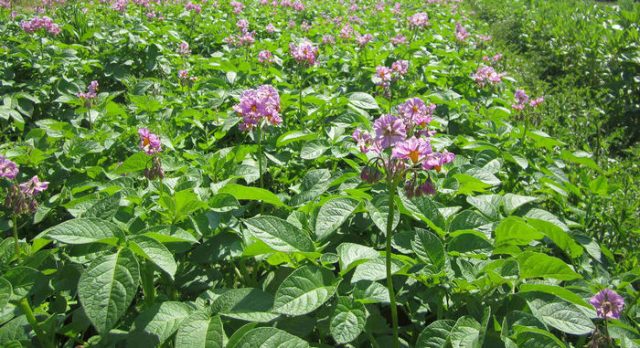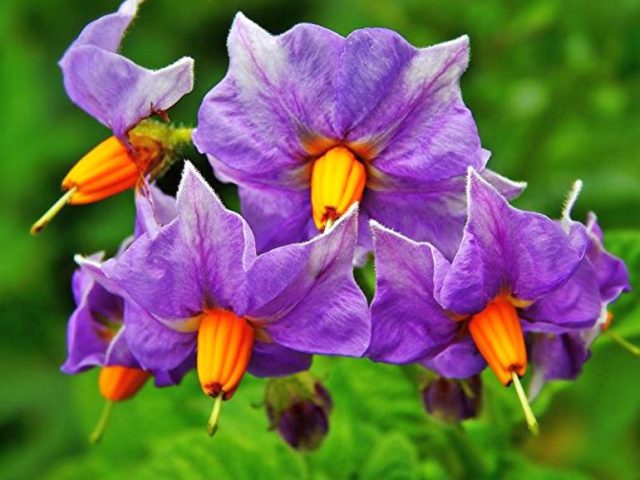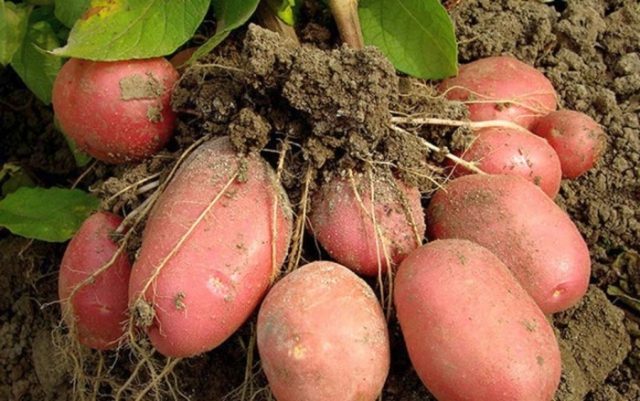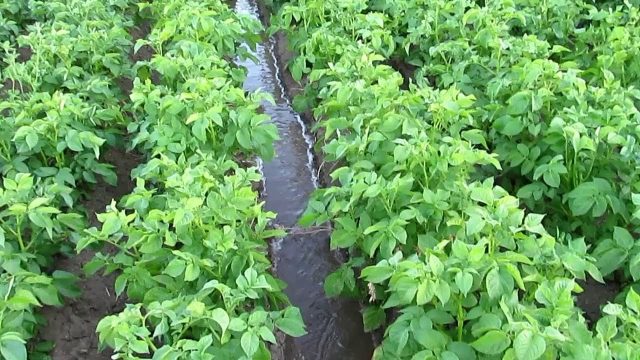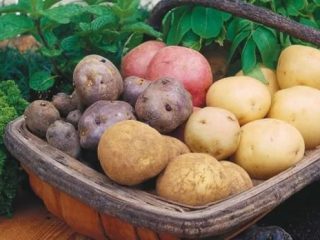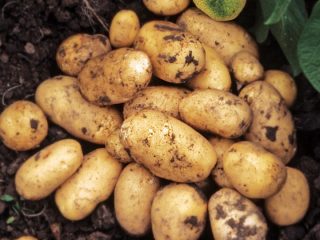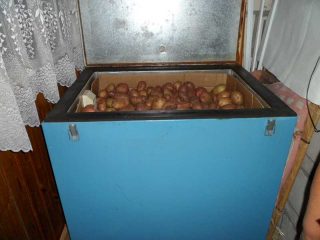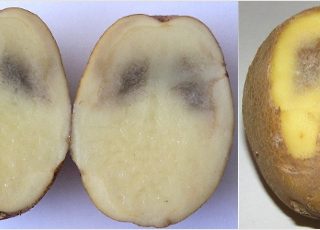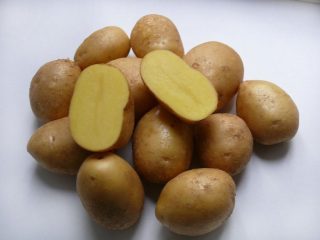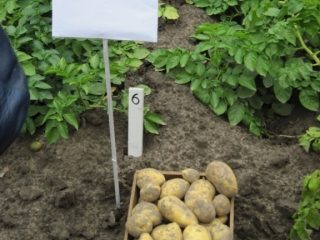Content
Izyuminka potatoes (shown in the photo) are a high-yielding variety characterized by increased resistance to fungal and viral diseases. When choosing a variety, vegetable growers pay attention to the purpose of the potato, its varietal characteristics, taste and shelf life. The variety has undergone long-term selection tests, as a result of which it is able to satisfy the needs of even the most experienced vegetable farmers. The originator of the Izyuminka variety is VNIIKH named after. A.G. Lorja. The variety has not yet been included in the State Register.
Description of the potato variety Izyuminka
Izyuminka potatoes belong to mid-season varieties, since the duration of formation and ripening of tubers is about 110 days from the moment of emergence.
The potato bush is compact in size. The shoots are erect, reaching 50-70 cm in height. The leaves are a rich green hue and have a shiny, hairless surface. The leaf sizes are medium.
Flowering in the Izyuminka variety is observed 4 weeks after the emergence of seedlings above the ground. The flowers are purple with a reddish tint.
According to the description of the variety, the Izyuminka potato, shown in the photo, is characterized by increased drought resistance, which allows it to be grown in regions with minimal rainfall.
Potato tubers have an oblong-oval shape. The eyes are shallow, at the stage of technical ripeness they are smooth, and when ripe they become rough.
The skin of the root vegetables is colored red. The cross-section shows that the potato flesh is yellow.
Potato yield
The yield indicator depends on the seed material used and adherence to agricultural technology. With proper planting, good performance can be achieved. According to reviews from vegetable growers, about 15 medium-sized and large-sized potatoes are collected from each Izyuminka bush.
Taste qualities
The taste of potatoes depends on the percentage of starch in it. For the Izyuminka variety, this figure ranges from 16-18%. This means that the variety is a high-starch crop, so it cooks well. These tubers are used for baking, boiling, and making purees. According to the taste rating scale, Izyuminka potatoes received 4.5 points out of 5.
Pros and cons of the variety
The Izyuminka potato variety has both positive qualities and some disadvantages. Among the advantages are:
- good taste;
- long shelf life of tubers - up to 10 months;
- large tuber size;
- high immunity to cancer, late blight and scab;
- average resistance to leaf curl virus, mosaic, nematode;
- increased drought resistance, the variety is suitable for growing in the middle zone and southern regions.
The Izyuminka variety has no significant disadvantages. Vegetable growers highlight the following disadvantages:
- long ripening period;
- the taste of potatoes appears only after ripening, which means this variety is not suitable as an early potato;
- Sprouts damaged in spring do not recover well.
Planting and caring for potatoes Zest
To increase potato yields, you need to know the secrets of growing them. The correct planting scheme allows you to save space and get a good harvest. The yield is influenced by the planting location, timely application of fertilizers, watering, loosening the soil and weeding from weed. Recommendations for agricultural technology are given below.
Selection and preparation of a landing site
Potatoes of the Izyuminka variety take about three months to ripen, so you should choose a sunny place so that the tubers have time to ripen. The soil must be fertile, without stagnant moisture. Excessive moisture leads to the development of fungal diseases.
Preparation of planting material
Preliminary preparation consists of germinating the tubers. Various germination methods can be used:
- dry;
- wet;
- combined.
During dry germination, Izyuminka potatoes are laid out in boxes in 1-2 layers and suitable conditions are created: light and temperature. For the first 10 days, to awaken the eyes, potatoes are kept at +18 °C, then the temperature is lowered to +14 °C. Such a decrease in temperature does not allow the sprouts to stretch out and grow vigorously; this is an additional hardening for them.
Wet germination is considered more effective, but it will require boxes with wet sawdust or peat. The potatoes are placed in a container and covered with a damp substrate. The room should be dark, the temperature should be maintained at +15 °C.With this method of preparation, the tubers produce sprouts and roots, which speeds up the germination process in the ground. Preparing tubers using this method takes 15 to 20 days.
Before planting, potatoes are treated with the growth stimulator Poteytin. To process 50 kg of seed material, you will need 1 liter of water and 1 ampoule of the drug.
For pre-planting treatment, complex products containing microelements necessary for the full development of potatoes are used. For example, the Micom preparation used for spraying tubers contains boron, zinc, copper, manganese and molybdenum.
To combat soil pests and diseases, tubers are treated with insectofungicidal agents – “Prestige”, “Maxim”.
Landing rules
The method of planting potatoes depends on the quality of the soil and weather conditions in the growing region. There are three classic planting methods:
- smooth (like a shovel);
- ridge;
- trench.
The ridge method is used in areas where groundwater passes close to the surface. The soil in the beds is too wet, so a tractor makes ridges into which the potatoes are buried.
The trench method is used where the land quickly dries out. If you make ridges in sandstones, they will have to be watered daily, and in trenches moisture does not evaporate so quickly.
Potatoes are planted under a shovel in small areas of sandy and sandy loam soil. In clay soil, planting under a shovel does not give a good harvest.
On light soils, they are deepened to a maximum of 12 cm, on loams - up to 10 cm, and in clay soils they are buried no deeper than 5 cm. The distance between rows should be about 70 cm, between adjacent holes in a row - 30 cm.
Watering and fertilizing
The amount of watering must be adjusted based on weather conditions. If there is no rain and the soil is dry, the potatoes require moisture, but if it rains and the beds are wet, watering should be delayed.
General recommendations for watering:
- a good time for watering is in the evening; if you water in the morning, the moisture from the leaves may not have time to evaporate, which will lead to sunburn on the tops;
- each bush requires at least 3 liters of water;
- choose the irrigation method that is most convenient in a particular situation. In a small area, root irrigation is used; in large fields, the drip irrigation method and furrow irrigation are used.
Top dressing can be root and foliar. The following are used as roots:
- bird droppings diluted with water in a ratio of 1:10. The mixture is poured into the furrows between the holes;
- urea is dissolved in water. For 10 liters of water add 1 tbsp. l. substances and apply 0.5 liters under each bush;
- mullein is also diluted with water. A bucket of water will require 1 liter of liquid mullein. After fermentation, the mixture is watered between the rows;
- weed infusion. The grass is crushed and soaked in water for several days; after fermentation, the solution is used to water potatoes;
- mineral fertilizing – nitrogen, phosphorus, potassium.
Foliar fertilizers for potatoes of the Izyuminka variety:
- urea (5 liters of water, 0.1 kg of urea, 0.15 kg of potassium monophosphate and 5 g of boric acid). The first time feeding is carried out 14 days after the sprouts appear. The plant is sprayed with a solution diluted 2 times.After 2 weeks, the procedure is repeated, but the liquid is used undiluted. Treat only before flowering;
- phosphorus fertilizing increases yield and affects the amount of starch in tubers. To treat bushes on an area of 10 m², you will need 10 liters of water and 100 g of superphosphate.
Loosening and weeding
Loosening with a rake on the 6th day after planting allows you to speed up the germination of potatoes. Subsequently, loosening is carried out after rains and waterings in order to break the crust that has formed on the ground.
Weeding is necessary to remove weeds from the beds. The procedure is carried out several times a season as the grass grows.
Hilling
It is recommended to carry out the first hilling as early as possible. The height of the tops can serve as a guide. If the greenery has stretched 15-20 cm above the ground, start hilling.
The second time the event is held 14 days later. It is believed that two hillings per season are enough for potatoes, but if the tubers are visible above the ground, repeated hilling is indispensable.
Diseases and pests
According to the description of the variety and reviews from vegetable growers, the Izyuminka potato is highly resistant to cancer, Alternaria, rhizoctonia and potato nematode, and shows average resistance to late blight and fomoz. The variety is susceptible to scab. Disease prevention involves pre-planting treatment of tubers.
Insects that can harm potatoes include Colorado potato beetles, mole crickets, wireworms and false wireworms.
To combat insects, chemicals are used, and it is also recommended to observe crop rotation and dig up the soil in the fall.
Harvesting and storage
The first signal for harvesting is the wilting of the tops.Harvest dates vary by region, but potatoes should be dug up before the ground freezes. Dig up potatoes in dry weather. Each bush is carefully dug up with a pitchfork or shovel and pulled by the tops.
Before being sent for storage, the potatoes are air-conditioned in a shady place, then they are sorted and sorted. Can be stored in the basement at a temperature of 2-4 °C. The room should be dark and dry. There must be a ventilation system, otherwise the potatoes will get wet and begin to rot.
To keep potatoes longer, they are treated with copper sulfate. For 10 liters of water you will need 2 g of dry vitriol. The collected root crops are sprinkled with this solution and dried well before being lowered into the cellar.
Conclusion
Izyuminka potatoes are a drought-resistant variety suitable for growing in the southern regions and central Russia. The tubers are distinguished by their high starch content and excellent taste.
